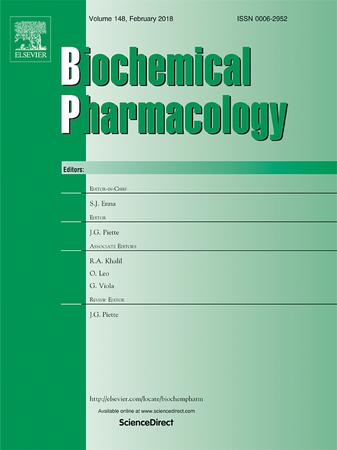2-aminothiazole 衍生物对乙醇诱导的体内斑马鱼致畸效应的保护作用。
IF 5.3
2区 医学
Q1 PHARMACOLOGY & PHARMACY
引用次数: 0
摘要
畸胎学研究先天性残疾的起源,这通常与环境因素有关,如接触乙醇(EtOH)。150 μM 的乙醇与致畸作用、氧化应激、免疫反应和内分泌紊乱有关。胎儿酒精谱系障碍(FASD)源于母亲在怀孕期间饮酒,导致发育迟缓和认知障碍。由于氨基噻唑衍生物具有多种治疗用途,因此在药物开发中至关重要。本研究旨在确定 2-氨基噻唑衍生物,特别是 1-(4-氯苯基)-N-(6-硝基苯并[d]噻唑-2-基)乙烷-1-亚胺(N4)化合物,是否能在斑马鱼模型中减少胚胎暴露于乙醇引起的致畸效应。在为期 7 天的实验中,使用三种处理浓度(50、100 和 150 μM)对斑马鱼幼体的致畸效应、死亡率、运动行为、氧化应激、基因表达和组织损伤进行了评估。结果表明,EtOH 会导致暴露幼虫的头部、眼睛和体长出现形态缺陷,同时还会导致行为异常和氧化损伤。N4 以浓度依赖性的方式有效减轻了这些毒性效应,减少了氧化损伤,防止了致畸效应,并避免了暴露于乙醇引起的组织损伤。这项研究强调了 N4 在增强抗氧化和抗炎作用以对抗乙醇诱导的氧化应激方面的潜力,为治疗 FASD 提供了有前景的治疗策略。本文章由计算机程序翻译,如有差异,请以英文原文为准。

Protective role of 2-aminothiazole derivative against ethanol-induced teratogenic effects in-vivo zebrafish
Teratology investigates the origins of congenital disabilities, often linked to environmental factors such as ethanol (EtOH) exposure. Ethanol at 150 μM has been associated with teratogenic effects, oxidative stress, immunological responses, and endocrine disruptions. Fetal alcohol spectrum disorder (FASD) arises from maternal alcohol consumption during pregnancy, leading to developmental delays and cognitive impairment. Due to their diverse therapeutic applications, amino thiazole derivatives are crucial in drug development. This study aimed to determine whether the 2-amino thiazole derivative, notably the 1-(4-chlorophenyl)-N-(6-nitrobenzo[d]thiazol-2-yl)ethan-1-imine (N4) compound, reduces teratogenic effects induced by embryonic EtOH exposure in a zebrafish model. Teratogenic effects, mortality, locomotion behaviour, oxidative stress, gene expression, and tissue damage were evaluated in larvae over a 7-day experimental period using three treatment concentrations (50, 100, and 150 μM). Results showed that EtOH induced morphological defects in the head, eyes, and body length of exposed larvae, along with behavioural abnormalities and oxidative damage. N4 effectively mitigated these toxic effects in a concentration-dependent manner, reducing oxidative damage, preventing teratogenic effects, and averting tissue damage induced by EtOH exposure. This study highlights the potential of N4 to enhance antioxidant and anti-inflammatory effects against ethanol-induced oxidative stress, offering promising therapeutic strategies for FASD treatment.
求助全文
通过发布文献求助,成功后即可免费获取论文全文。
去求助
来源期刊

Biochemical pharmacology
医学-药学
CiteScore
10.30
自引率
1.70%
发文量
420
审稿时长
17 days
期刊介绍:
Biochemical Pharmacology publishes original research findings, Commentaries and review articles related to the elucidation of cellular and tissue function(s) at the biochemical and molecular levels, the modification of cellular phenotype(s) by genetic, transcriptional/translational or drug/compound-induced modifications, as well as the pharmacodynamics and pharmacokinetics of xenobiotics and drugs, the latter including both small molecules and biologics.
The journal''s target audience includes scientists engaged in the identification and study of the mechanisms of action of xenobiotics, biologics and drugs and in the drug discovery and development process.
All areas of cellular biology and cellular, tissue/organ and whole animal pharmacology fall within the scope of the journal. Drug classes covered include anti-infectives, anti-inflammatory agents, chemotherapeutics, cardiovascular, endocrinological, immunological, metabolic, neurological and psychiatric drugs, as well as research on drug metabolism and kinetics. While medicinal chemistry is a topic of complimentary interest, manuscripts in this area must contain sufficient biological data to characterize pharmacologically the compounds reported. Submissions describing work focused predominately on chemical synthesis and molecular modeling will not be considered for review.
While particular emphasis is placed on reporting the results of molecular and biochemical studies, research involving the use of tissue and animal models of human pathophysiology and toxicology is of interest to the extent that it helps define drug mechanisms of action, safety and efficacy.
 求助内容:
求助内容: 应助结果提醒方式:
应助结果提醒方式:


